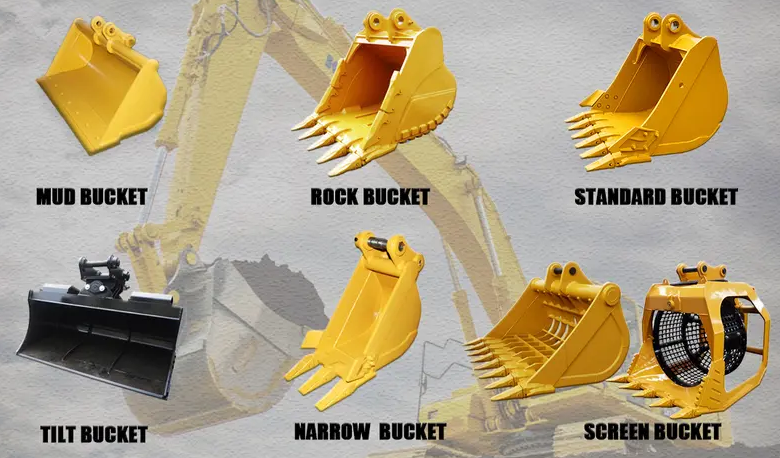Excavator buckets are essential attachments that increase the versatility of excavators for various tasks. Understanding the different types of buckets and their specific uses can help you select the right one for your project. Here’s what you need to know:

different types of excavator buckets:
1. Standard Bucket
- Description:
- A general-purpose bucket with a broad, flat base.
- Uses:
- Ideal for digging, lifting, and moving materials such as soil, gravel, and sand.
2. Heavy-Duty Bucket
- Description:
- A robust version of the standard bucket, made from thicker materials.
- Uses:
- Suitable for tougher jobs involving abrasive materials like hard clay and rocky soil.
3. Digging Bucket
- Description:
- Features a sharper edge for effective digging capabilities.
- Uses:
- Perfect for deep excavation tasks, such as foundations and trenches.
4. Trenching Bucket
- Description:
- A narrow bucket designed for digging precise trenches.
- Uses:
- Utility installation, drainage work, and other applications requiring deep, narrow excavations.
5. Grading Bucket
- Description:
- Flat-bottomed with straight sides to facilitate leveling.
- Uses:
- Land grading, smoothing surfaces, and finish grading.
6. Rock Bucket
- Description:
- Reinforced with larger teeth to handle heavy materials.
- Uses:
- Excavating rocky terrain, moving boulders, and clearing debris.
7. Skeleton Bucket
- Description:
- Features a grid-like structure for sifting materials.
- Uses:
- Separating rocks from soil or clearing land while leaving finer materials behind.
8. Mud Bucket
- Description:
- Designed with a wider profile for handling wet materials.
- Uses:
- Excavating in muddy or wet conditions, such as ditches or marshy areas.
9. Multi-Tool Bucket
- Description:
- A versatile bucket that can be fitted with various attachments.
- Uses:
- Adaptable for multiple tasks, including grading, digging, and material handling.

Summary Table of Excavator Buckets
| Bucket Type | Description | Uses |
|---|---|---|
| Standard Bucket | General-purpose with a broad base | Digging, lifting, moving materials |
| Heavy-Duty Bucket | Thicker materials for durability | Tough jobs with abrasive materials |
| Digging Bucket | Sharp edge for effective digging | Deep excavation tasks |
| Trenching Bucket | Narrow design for precise trenches | Utility installation, drainage work |
| Grading Bucket | Flat-bottomed for leveling | Land grading, smoothing surfaces |
| Rock Bucket | Reinforced for heavy materials | Excavating rocky terrain |
| Skeleton Bucket | Grid structure for sifting | Separating rocks from soil |
| Mud Bucket | Wider profile for wet materials | Excavating in muddy conditions |
| Multi-Tool Bucket | Interchangeable attachments | Various tasks |
Conclusion
Choosing the right excavator bucket for your specific needs can greatly enhance efficiency and productivity on the job site. Each bucket type is designed for specific applications, so understanding their characteristics is vital. If you have any further questions or need help selecting the right bucket, feel free to ask!